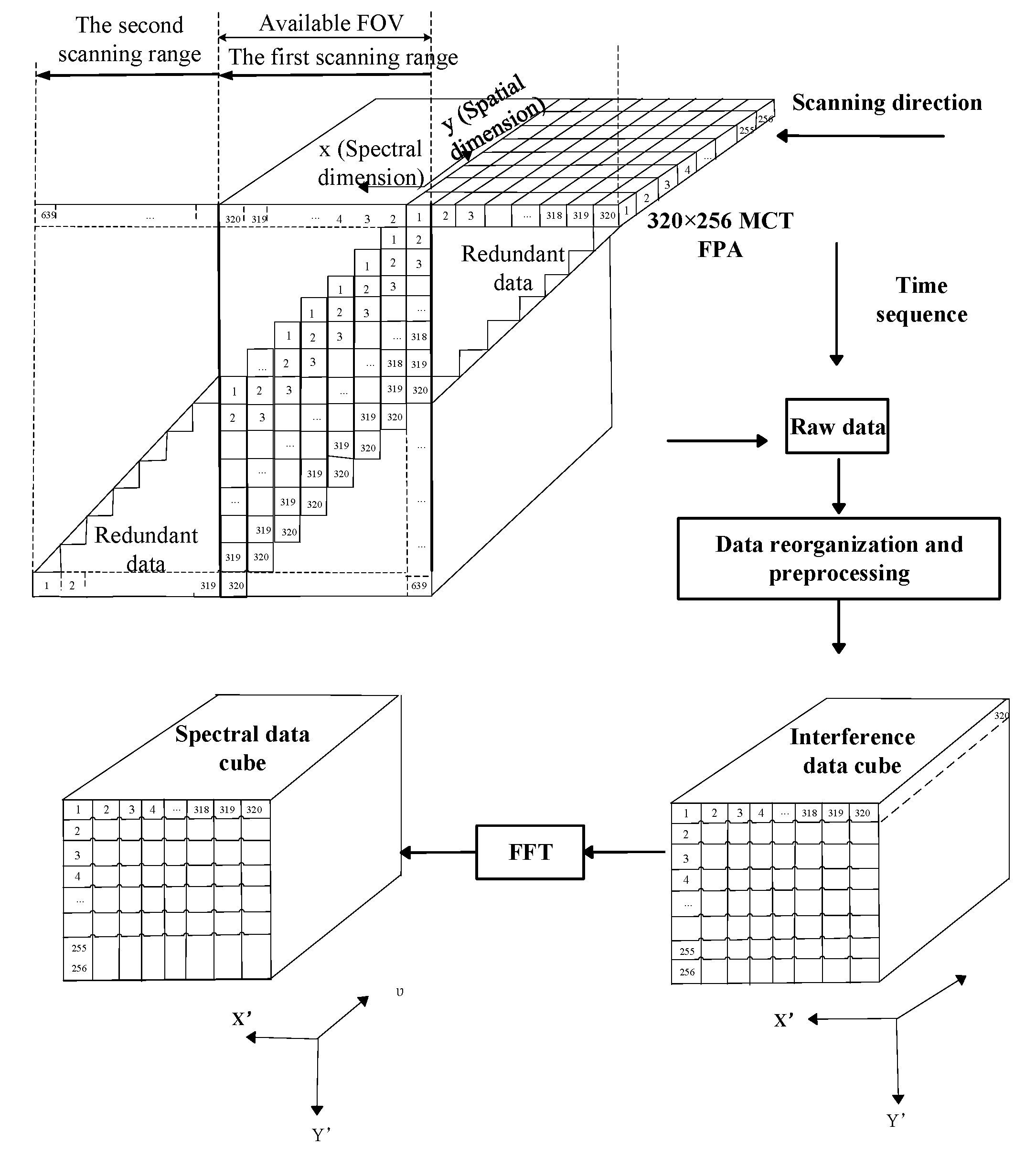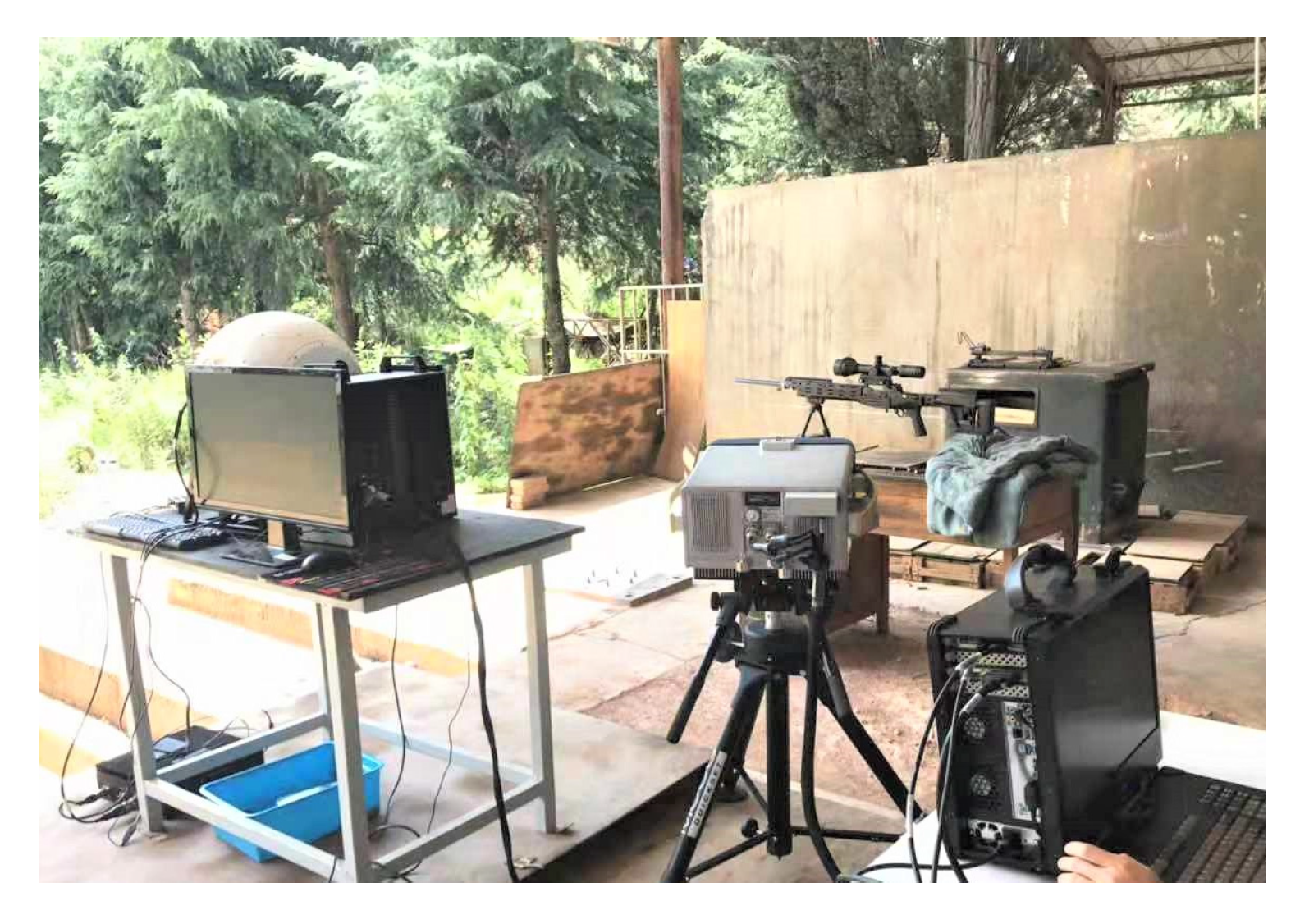Spectral Measurements of Muzzle Flash with a Temporally and Spatially Modulated LWIR-Imaging Fourier Transform Spectrometer
Abstract
:1. Introduction
2. The Experimental System
3. Results and Discussions
3.1. The Interference Diagram of Muzzle Flash
3.2. The Spectra of Muzzle Flash
3.3. The Radiance of Muzzle Flash
3.4. The Brightness Temperature of Muzzle Flash
3.5. Gas Telemetering
4. Conclusions
Author Contributions
Funding
Institutional Review Board Statement
Informed Consent Statement
Data Availability Statement
Acknowledgments
Conflicts of Interest
References
- Harley, J.L.; Rankin, B.A.; Blunck, D.L.; Gore, J.P.; Gross, K.C. Imaging fourier-transform spectrometer measurements of a turbulent nonpremixed jet flame. Opt. Lett. 2014, 39, 2350–2353. [Google Scholar] [CrossRef] [PubMed] [Green Version]
- Tsukino, K.; Satoh, T.; Ishii, H.; Nakata, M. Development of a multichannel fourier-transform spectrometer to measure weak chemiluminescence: Application to the emission of singlet-oxygen dimol in the decomposition of hydrogen peroxide with gallic acid and K3[Fe (CN)6. Chem. Phys. Lett. 2008, 457, 444–447. [Google Scholar] [CrossRef]
- Rao, H.L.; Zangwill, L.M.; Weinreb, R.N.; Sample, P.A.; Medeiros, F.A. Comparison of different spectral domain optical coherence tomography scanning areas for glaucoma diagnosis. Ophthalmology 2010, 117, 1692–1699. [Google Scholar] [CrossRef] [PubMed]
- Amato, U.; Cuomo, V.; Serio, C. An advanced optimal spectral estimation algorithm in fourier spectroscopy with application to remote sensing of the atmosphere. J. Appl. Meteorol. 2010, 32, 1508–1520. [Google Scholar] [CrossRef]
- Azatyan, V.V. Features of the physicochemical mechanisms and kinetic laws of combustion, explosion, and detonation of gases. Kinet. Catal. 2020, 61, 319–338. [Google Scholar] [CrossRef]
- Liu, M.B.; Liu, G.R.; Zong, Z.; Lam, K.Y. Computer simulation of high explosive explosion using smoothed particle hydrodynamics methodology. Comput. Fluids 2003, 32, 305–322. [Google Scholar] [CrossRef]
- Steward, B.J.; Perram, G.P.; Gross, K.C. Modeling midwave infrared muzzle flash spectra from unsuppressed and flash-suppressed large caliber munitions. Infrared Phys. Techn. 2012, 55, 246–255. [Google Scholar] [CrossRef]
- Law, D.B.; Carapezza, E.M.; Csanadi, C.J.; Edwards, G.D.; Tong, R.M. Multispectral signature analysis measurements of selected sniper rifles and small arms. In Proceedings of the SPIE 2938, Boston, MA, USA, 18 February 1997. [Google Scholar]
- Ashcroft, A.; Richardson, L.; Ash, R.; Thorne, P.; Malik, A. A miniature ruggedized fast frame rate infrared sensor module for hostile fire detection and industrial applications. In Proceedings of the SPIE 8704, Baltimore, MD, USA, 11 June 2013. [Google Scholar]
- Kastek, M.; Dulski, R.; Trzaskawka, P.; Piątkowski, T.; Polakowski, H. Spectral measurements of muzzle flush with multispectral and hyperspectral sensor. In Proceedings of the SPIE 8193, Beijing, China, 24 May 2011. [Google Scholar]
- Sabbah, S.; Harig, R.; Rusch, P.; Eichmann, J.; Keens, A.; Gerhard, J.H. Remote sensing of gases by hyperspectral imaging: System performance and measurements. Opt. Eng. 2012, 51, 111717. [Google Scholar] [CrossRef]
- Puckrin, E.; Turcotte, C.S.; Gagnon, M.; Bastedo, J.; Chamberland, M. Airborne infrared hyperspectral imager for intelligence, surveillance and reconnaissance applications. In Proceedings of the SPIE 8542, Edinburgh, UK, 24 September 2012. [Google Scholar]
- Zheng, W.J.; Jin, W.Q.; Su, J.H. The study on chemical vapor passive infrared standoff remote sensing. In Proceedings of the SPIE 6621, Beijing, China, 9 September 2007. [Google Scholar]
- Zheng, W.J.; Yu, C.H.; Yang, Z.X.; Zhang, W.F.; Wang, H.W.; Lei, Z.G.; Yuan, X.C.; Zhang, P.Z.; Yan, M.; Zheng, Z.M. Remote sense for environment pollution gases in wide infrared spectral range. Infrared Laser Eng. 2019, 48, 1104002. [Google Scholar] [CrossRef]
- Su, L.; Yuan, Y.; Xiangli, B.; Huang, F.; Zhou, S. Spectrum reconstruction method for airborne temporally–spatially modulated fourier transform imaging spectrometers. In Proceedings of the IEEE Conference on Geoence & Remote Sensing, Quebec City, QC, Canada, 13 July 2014. [Google Scholar]
- Huang, F.Z.; Yuan, Y.; Li, J.Z.; Cao, J. Spectrum reconstruction using relative-deviation-based kernel regression in temporally and spatially modulated Fourier transform imaging spectrometer. Appl. Opt. 2015, 54, 6737–6743. [Google Scholar] [CrossRef] [PubMed]









Disclaimer/Publisher’s Note: The statements, opinions and data contained in all publications are solely those of the individual author(s) and contributor(s) and not of MDPI and/or the editor(s). MDPI and/or the editor(s) disclaim responsibility for any injury to people or property resulting from any ideas, methods, instructions or products referred to in the content. |
© 2023 by the authors. Licensee MDPI, Basel, Switzerland. This article is an open access article distributed under the terms and conditions of the Creative Commons Attribution (CC BY) license (https://creativecommons.org/licenses/by/4.0/).
Share and Cite
Yang, Z.; Li, K.; Yu, C.; Yuan, M.; Wang, B.; Feng, J. Spectral Measurements of Muzzle Flash with a Temporally and Spatially Modulated LWIR-Imaging Fourier Transform Spectrometer. Sensors 2023, 23, 3862. https://doi.org/10.3390/s23083862
Yang Z, Li K, Yu C, Yuan M, Wang B, Feng J. Spectral Measurements of Muzzle Flash with a Temporally and Spatially Modulated LWIR-Imaging Fourier Transform Spectrometer. Sensors. 2023; 23(8):3862. https://doi.org/10.3390/s23083862
Chicago/Turabian StyleYang, Zhixiong, Kun Li, Chunchao Yu, Mingyao Yuan, Boyang Wang, and Jie Feng. 2023. "Spectral Measurements of Muzzle Flash with a Temporally and Spatially Modulated LWIR-Imaging Fourier Transform Spectrometer" Sensors 23, no. 8: 3862. https://doi.org/10.3390/s23083862




